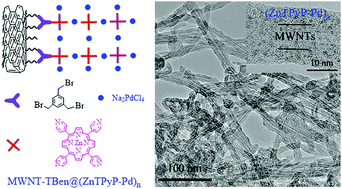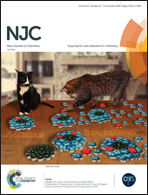Fabrication of carbon nanotube-multiporphyrin array composites as light-sensitizer for photocurrent generation, photochromism of viologen and catalytic degradation of methyl orange†
Abstract
Multiporphyrin arrays play an important role as active light-sensitizers in photo-induced energy and electron transfer processes. Here, we report a palladium-directed self-assembly of multiporphyrin arrays on the surfaces of multi-walled carbon nanotubes (MWNTs) using zinc tetrapyridylporphyrin (ZnTPyP) as a multidentate linker to produce light sensitive nano-composites for photocurrent generation, photochromism of viologen, and catalytic degradation of a dye. The hydroxylated MWNTs were first reacted with aminopropyltrimethoxysilane (APTMS) and 1,3,5-tris(bromomethyl)benzene (TBenBr) to form MWNT–TBenBr nano-hybrids, followed by a substitution reaction with ZnTPyP to produce MWNT–TBen@ZnTPyP nano-cores, which were then used as a platform to construct MWNT–TBen@(ZnTPyP–Pd)n nano-composites and three-dimensional multilayers. The nano-materials were characterized using thermogravimetry, infrared, Raman, UV-Vis absorption, fluorescence, and X-ray photoelectron spectroscopy, as well as using field emission transmission electron microscopy (FE-TEM). For the MWNT–TBen@(ZnTPyP–Pd)n nano-composites, the porphyrin Soret absorption band appeared at 426 nm and their fluorescence emissions at 605 and 654 nm, indicating that the ZnTPyP macrocycles were loosely packed on the MWNTs’ surfaces. The FE-TEM images indicated that the average layer thickness of the multiporphyrin arrays was approximately 0.9–1.5 nm. Owing to co-assembly of the conductive MWNTs, the photocurrent intensity for the electrode covered by the MWNT–TBen@(ZnTPyP–Pd)3 multilayers was twice as strong as that by the (ZnTPyP–Pd)3 ones. Further, as a heterogeneous photo-catalyzer, the nano-composites showed a degradation rate for methyl orange (MO) of about 6 × 10−3 MO/ZnTPyP s. Finally, because ZnTPyP was strongly immobilized on the MWNTs’ surfaces through coordination bonding, the nano-composites and their multilayers showed good stability, reusability, and recyclability.



 Please wait while we load your content...
Please wait while we load your content...